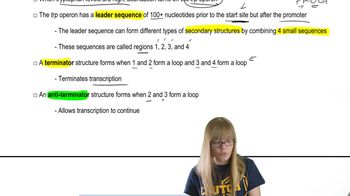Attenuation uses what molecule to regulate the trp operon?
Table of contents
- 1. Introduction to Genetics51m
- 2. Mendel's Laws of Inheritance3h 37m
- 3. Extensions to Mendelian Inheritance2h 41m
- 4. Genetic Mapping and Linkage2h 28m
- 5. Genetics of Bacteria and Viruses1h 21m
- 6. Chromosomal Variation1h 48m
- 7. DNA and Chromosome Structure56m
- 8. DNA Replication1h 10m
- 9. Mitosis and Meiosis1h 34m
- 10. Transcription1h 0m
- 11. Translation58m
- 12. Gene Regulation in Prokaryotes1h 19m
- 13. Gene Regulation in Eukaryotes44m
- 14. Genetic Control of Development44m
- 15. Genomes and Genomics1h 50m
- 16. Transposable Elements47m
- 17. Mutation, Repair, and Recombination1h 6m
- 18. Molecular Genetic Tools19m
- 19. Cancer Genetics29m
- 20. Quantitative Genetics1h 26m
- 21. Population Genetics50m
- 22. Evolutionary Genetics29m
12. Gene Regulation in Prokaryotes
Tryptophan Operon and Attenuation
Problem 2i
Textbook Question
Transcriptional regulation of operon gene expression involves the interaction of molecules with one another and of regulatory molecules with segments of DNA. In this context, define and give an example of each of the following:
Attenuation
 Verified step by step guidance
Verified step by step guidance1
Define attenuation: Attenuation is a regulatory mechanism in prokaryotes, particularly in operons like the trp operon, where transcription is prematurely terminated based on the interaction between transcription and translation processes.
Explain the mechanism: Attenuation relies on the formation of specific secondary structures in the mRNA transcript, such as stem-loop structures, which can either terminate transcription or allow it to continue.
Provide an example: In the trp operon of *E. coli*, when tryptophan levels are high, a leader peptide is translated, causing the formation of a terminator stem-loop in the mRNA. This terminator structure halts transcription before the structural genes of the operon are transcribed.
Contrast with low tryptophan levels: When tryptophan levels are low, the ribosome stalls during translation of the leader peptide due to a lack of charged tRNA^Trp. This allows the formation of an anti-terminator stem-loop, enabling transcription of the structural genes.
Summarize the importance: Attenuation provides a fine-tuned mechanism for regulating gene expression in response to metabolite levels, ensuring that resources are conserved when the end product (e.g., tryptophan) is abundant.
 Verified video answer for a similar problem:
Verified video answer for a similar problem:This video solution was recommended by our tutors as helpful for the problem above
Video duration:
2mPlay a video:
Was this helpful?
Key Concepts
Here are the essential concepts you must grasp in order to answer the question correctly.
Attenuation
Attenuation is a regulatory mechanism in prokaryotic gene expression that controls transcription termination. It occurs in operons, where the formation of specific RNA structures in the leader region of mRNA can either promote or inhibit the continuation of transcription based on the presence of certain metabolites. For example, in the tryptophan operon, high levels of tryptophan lead to the formation of a hairpin structure that causes RNA polymerase to terminate transcription prematurely.
Recommended video:
Guided course

Trp Attenuation
Operon
An operon is a cluster of genes under the control of a single promoter, allowing for coordinated expression of genes that often encode proteins with related functions. In prokaryotes, operons enable efficient regulation of gene expression in response to environmental changes. The classic example is the lac operon, which is involved in lactose metabolism and is activated in the presence of lactose while being repressed in its absence.
Recommended video:
Guided course

Arabinose Operon
Transcriptional Regulation
Transcriptional regulation refers to the mechanisms that control the rate and timing of gene transcription, ensuring that genes are expressed at the right levels and times. This regulation can involve various factors, including transcription factors, enhancers, silencers, and regulatory RNAs. In the context of operons, transcriptional regulation allows cells to respond quickly to changes in their environment, such as nutrient availability.
Recommended video:
Guided course

Eukaryotic Transcription
Related Videos
Related Practice
Multiple Choice
524
views
2
rank


